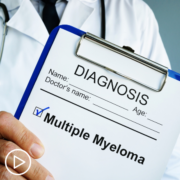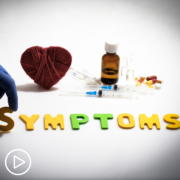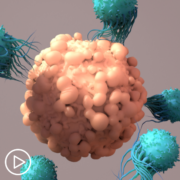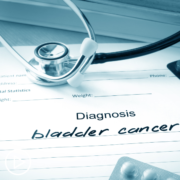Understanding Myeloma Treatment Types
Understanding Myeloma Treatment Types from Patient Empowerment Network on Vimeo.
What are the types of treatment available for myeloma? Myeloma expert Dr. Mark Schroeder reviews the myeloma treatment classes, including proteasome inhibitors, immunomodulatory drugs (iMids), and immunotherapy. Dr. Schroeder also discusses factors to consider when choosing therapy for patients with myeloma.
Dr. Mark Schroeder is a hematologist at Siteman Cancer Center of Washington University School of Medicine in St. Louis. Dr. Schroeder serves as Associate Professor in the Department of Medicine. Learn more about Dr. Schroeder.
See More from Engaging in Myeloma Treatment Decisions
Related Resources:

|

|

|
Transcript:
Katherine Banwell:
There are a number of treatments for myeloma patients. Can you talk about the types that are available?
Dr. Mark Schroeder:
Yeah. So, the classes of – actually there is lots of drugs approved for treating myeloma but also recently approved.
And we classify them into big categories. One of the categories is called immunomodulatory drugs – those are drugs like lenalidomide (Revlimid) and pomalidomide (Pomalyst), or even thalidomide (Thalomid), which was one of the first immunomodulatory drugs. Those are oral drugs that work on a specific pathway in the myeloma that leads to the myeloma cell dying. Another class of drugs are called proteasome inhibitors. Those include drugs like bortezomib or carfilzomib. Those drugs are often given under the skin or in the vein, and we know that they work really effectively on their own, but also when we combine them with an immunomodulatory drug like Revlimid or pomalidomide, the effect is even better. Another class is steroids. Steroids are kind of one of the first drugs used to treat this cancer, and steroids are effective at treating myeloma cells.
Plasma cells are responsive to steroids. One of the first treatment regimens used to treat myeloma were traditional chemotherapies, and those are usually reserved for later on. You might think of traditional chemotherapy that causes hair loss, nausea, vomiting, low blood counts. Those, decades ago, were used to treat myeloma, but now we have effective oral, IV, or injection into the skin that don’t cause a lot of the traditional chemotherapy side effects but are very effective at treating the myeloma. And then another major class of drugs are considered immunotherapies. So, these are treatments that are engineered to either stimulate the immune system to go attack the myeloma, or maybe it’s even using part of your own immune system to engineer it to go attack the myeloma.
Examples of those are called bispecific antibodies which kind of binds to the myeloma but binds to an immune cell, brings them together, or a CAR T-cell which takes your own T cells genetically modifies them to attack the cancer.
Katherine Banwell:
And there is also a bone marrow transplant. Is that right?
Dr. Mark Schroeder:
That’s right, yeah. I neglected – so, bone marrow transplant has been around for a while in myeloma. And despite it being around for so long and really good therapies being approved for myeloma, it’s still a standard treatment for myeloma. And bone marrow transplant in myeloma uses a traditional chemotherapy called melphalan that is associated with the chemotherapy side effects we talked about. But the advantage of bone marrow transplant is that it prolongs the time before the myeloma comes back and needs other treatments, and that’s why we do it. It can be toxic, but it can prolong the time before a patient needs another line of therapy.
Katherine Banwell:
We know that everyone’s diagnosis is different. So, how do you determine a treatment plan for an individual patient?
Dr. Mark Schroeder:
So, it depends in terms of the patient – initially, I will evaluate patients and determine how fit they are. Is it a patient that I think is strong enough to undergo a stem cell transplant? Is that going to be a benefit to them? That’s not necessarily a factor of just age, but it’s also, are they doing well functionally, or do they have any other medical problems like heart disease or kidney problems? Those things play into my decision on a treatment initially with patients.
So, whether you’re fit or unfit will help to guide what your treatment is going to be in general. Fit patients are somebody that could undergo multiple treatments, go through a transplant, have minimal toxicity, and recover fully after more intensive treatments.
Whereas, unfit may need more assistance, and we tend to reduce the intensity of treatments. It doesn’t mean the treatments, if you’re unfit, are less effective – they can be very effective. But our goals for treatment change in that situation. And we’re looking for responses but also looking for quality of life. And then it changes also depending on the genetics of the myeloma. Our treatment for patients who have genetic changes that are high risk will change compared to those that have what are called standard risk genetic changes.
So, that is an important point to discuss with your oncologist if you have – Do I have standard risk or high-risk genetic changes in my cancer? And does that effect my treatment? And then also, treatment in somebody who is being treated a second time or third time or beyond for their myeloma depends on what treatments you had before and how effective they were.
And what were your toxicities or side effects from those treatments? So, all those factors play into a decision of treatment for an individual.










































